ABSTRACT
Recently, Virtual Reality (VR) has shown promise for changing Engineering Education (EE) to increase student learning results. However, VR-based education is not commonly used. This article examines VR technology’s growth and research possibilities in EE to understand its revolutionary impact on learning. Therefore, this study is essential so that researchers, educational institutions, and policymakers can make more informed and strategic decisions to support the development of engineering education based on VR technology. A thorough study of literature employing bibliometric methodology examines VR applications in EE. Scopus, which contained 1645 documents from 2012 to 2022, provided the analyzed papers on July 4, 2022. VOSViewer showed author networks, nations, journals, and keywords for bibliometric analysis. Over the past decade, VR and EE publications have risen. China produces the most VR/EE research, whereas Taiwanese authors are highly cited. Technologico de Monterrey is Mexico’s most active research institute for VR and EE, and computer and education journals are highly mentioned. VR’s research potential in EE emphasizes the need for further empirical investigations to determine its long-term effects on student academic performance, information retention, and learning outcomes. This essay contributes to the discussion on updating pedagogy and improving future engineers’ learning by making a persuasive case for VR in EE.
INTRODUCTION
The use of VR in education is currently a fascinating and prevalent topic being explored. VR has been widely used, with research demonstrating that its use as a pedagogical medium can give numerous benefits to enhance the learning and teaching experience. Students can develop abilities that are difficult to acquire using standard teaching and learning approaches using virtual environments.[1,2] Nonetheless, the practical effects of VR in new EE are worth investigating in depth.[3,4] It is owing to the scarcity of actual reality and EE research, which is crucial to the link between student educators and industry regarding learning abilities and projected learning results.
In 2017, a study investigated 68 studies from various levels of schooling (primary, secondary, and higher). When considered from an educational standpoint, the findings suggest that virtual environments can support teaching and learning. According to the review, virtual environments can improve learner outcomes by enhancing learning accomplishment and performance. In addition, the review discusses educational contributions such as greater student participation in learning.[5] Furthermore, research on 21 study programs showed that the virtual environment could improve educational features in various settings. The study discovered significant advantages for cognitive skills (remembering and comprehension), psychomotor abilities (visual and observational), and affective capacities (emotional control). The findings, however, show that using virtual worlds will have no added pedagogical value if the immersive experience only distracts from the learning job. According to the study results, VR research is profitable and promising for application in numerous areas of education.[6]
VR is a technology that generates an artificial digital environment, a computer-generated interactive experience to simulate a real-world setting. These technologies can build surroundings that resemble the real world or provide experiences that would be unattainable in ordinary physical reality. A VR headset or a multi-projection environment that combines accurate visual and audio feedback simulates the three-dimensional environment. VR arose theoretically in the 1960s, using sensorama simulators that may create the illusion of reality by stimulating the human senses of sight, hearing, smell, and touch with moving 3D pictures.[7,8] VR has played an essential part in the entertainment industry over the last few decades. However, since the 1980s, researchers have been testing the effectiveness of VR in education and training.[9,10] Because VR technology exists, it is possible to incorporate it into a new approach to education to supplement traditional learning methods.
Combining VR with education technology creates new learning approaches that may be used to enhance traditional ones. By adding sensory information, this unique technique boosts students’ enthusiasm for acquiring knowledge in novel ways.[11] VR aids in the learning of more precise demonstrations of functionality or activities. An essential aspect of VR in education is allowing students to recognize and explore abstract or complex knowledge observed in a risk-free environment.[12,13] Different study paths and aims are detailed within the framework of VR research, ranging from constructing a learning taxonomy to producing learning material for various areas so that their influence may substantially impact educational goals.[14–16] Other studies have been conducted in line with the predicted educational aims, such as the function of VR in creating learning motivation, attitudes, and cognitive load.[17–20] The fast growth of VR also offers new obstacles since it will alter study findings because certain factors must be maintained while assessing their effect so that the dynamic character of VR development does not interfere with educational aims.[21]
If educators want to embrace virtual learning environments, they must be prepared to provide interactive activities that promote student participation. Interactions between students in VR that are appropriately organized have a beneficial effect on the learning engagement of those students.[22,23] Utilizing virtual scenario tours that include video clips and geographical places on a map is one way that might be used for balanced learning. Additionally, integrating games’ components to draw students’ attention and supplementing it with viewing videos may increase learning outcomes.[24] However, other studies explain how the addition of immersive VR to learning can increase student engagement but, at the same time, may not necessarily increase knowledge levels.[25,26] Users in a VR environment may be startled and astonished by the new surroundings, distracting them from accomplishing the learning objectives. Although using VR for learning and training has various advantages, it is seldom employed because of the expensive cost of equipment, continuously expanding technology, and a lack of applications for immediate use because they must first go through a development or research process. The absence of concentrated studies on producing educational materials and implementing their standards is a barrier to the increased use of VR technology in education.[17,27] Although incorporating VR technology into the educational process presents a variety of hurdles and obstacles, there is a beneficial impact on improving learning through the different sensory elements inherent in VR. These features promote students’ capacity to engage in real-world learning experiences, give interactive simulations with various roles, increase teamwork, and boost memory.[28]
VR is beneficial at all stages of education, from elementary to university. VR has been used to support and improve learning in higher education.[29–31] However, VR-based solutions have numerouslimitationscomparedtotraditionalteachingtechniques. According to a study of the VR literature, not many researchers have experimentally studied the influence of technology on learning outcomes, with the bulk focused on its utility.[32] Many VR apps have been produced at this time. However, many developers lack the best practices for designing specific applications in the education industry, particularly in EE. According to the statistics, individual developers employ the programming languages JavaScript, C#, and Unity as the most often used software.[33,34] Virtual training simulators are two instances of VR material in science, technology, engineering, and mathematics education. Working in a laboratory is an essential element of education for engineering students.[35–37] Experiments in real-world and natural settings incur technological infrastructure, time, and space expenses. VR may help tackle these issues.[38–41] Robotics is one of the topics in which students may utilize a virtual environment. Industrial robotic arm simulations can execute better-designed trajectories without endangering students or ruining real-world equipment.[42] VR may also be utilized as a medium for remote learning, allowing students to study from home using other learning tools.[43,44]
Since the early twentieth century, bibliometrics analysis has been known.[45] Bibliometrics is a statistical method that collects consistent data from publications to describe authors, institutions, journal sources, and other sources of interest.[46] Because of the increasing quantity of research publications on a particular topic, it is efficient to utilize a few quantitative categories to assess the significance of achievements in that field.[47] The bibliometric result is reliable since a replicable and transparent review process assures it. The propensity of subjective literature analysis is eliminated by relying on objective assessments resulting from computer programming.[48] Furthermore, bibliometric research is not constrained by time or the number of data samples.[49] Food science and technology,[50,51] engineering,[52] computer science,[53] medicine,[54,55] education,[56] economics,[57–59] and social science[60] are all domains where bibliometric analysis is used.
Bibliometric analysis is used in research for several purposes, including developing trends in article and journal performance, cooperation patterns, and research constituencies and exploring the intellectual structure of a specific area in the current literature.[61] The data at the heart of the bibliometric analysis is often enormous (hundreds, if not thousands) and objective (e.g., amount of citations and publications, occurrences of keywords and subjects). However, interpretation frequently relies on both aims (e.g., performance analysis). Informed approaches and processes establish subjective judgments (for example, theme analysis). In other words, a bibliometric analysis may outline and map an established area’s accumulated scientific knowledge and evolutionary subtleties by rigorously interpreting vast amounts of unstructured data. As a result, well-conducted bibliometric research may provide the groundwork for expanding a discipline in novel and meaningful ways. It allows and empowers researchers to (1) gain a complete picture of the study being undertaken, (2) discover knowledge gaps, (3) obtain fresh insights and ideas for future examination of research issues, and (4) position the research’s contributions. However, to our knowledge, no comprehensive bibliometric study on VR and EE has been conducted. To provide up-to-date information regarding the development of research on VR in EE. Also, to provide recommendations or proposals for future research on VR technology as an educational instructional medium, a study is needed through literature research on VR and technical education using bibliometric analysis.
METHODOLOGY
The first step of the search was conducted in the Scopus database, and the collected documents were evaluated in three stages (Figure 1). Phase 1 identifies records in the Scopus database and refines the records obtained by defining search parameters (data collection phase). Phase 2 involves exporting the document to the VOSviewer program for bibliometric analysis of publications, authors, nations, institutions, journals, and regions (data visualization phase). The third phase aims to identify the critical topics highlighted in the study on VR and EE.
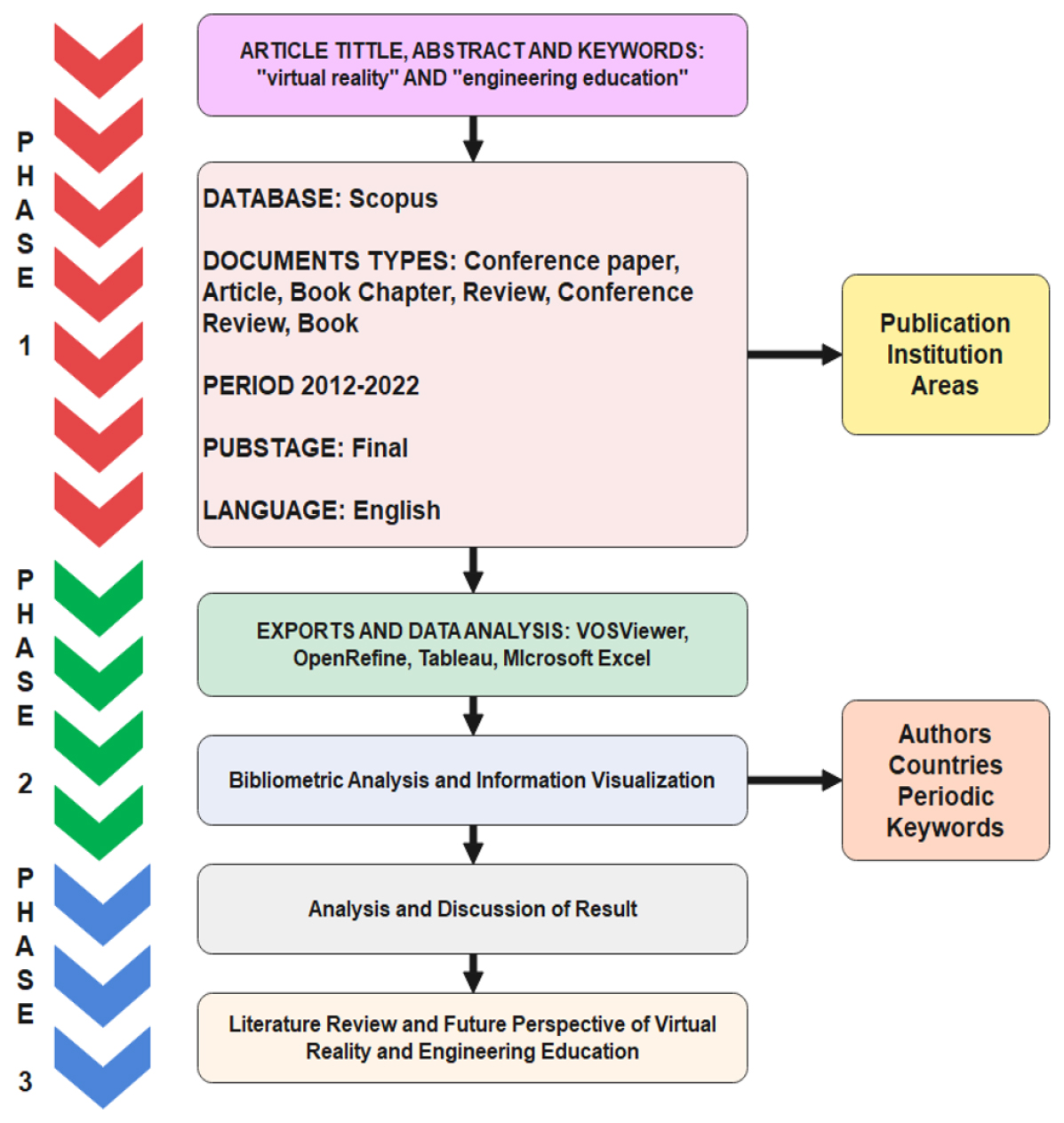
Figure 1:
Flow Chart Bibliometric Analysis Process.
To generate and visualize bibliometric networks, the VOSviewer software from Leiden University in Leiden, the Netherlands, version 1.6.17, was used. This software allows it to extract data from published works, including the author, magazine, organization, country, and keywords.[62] The Scopus database, regarded as appropriate for bibliometric research since it covers material published in indexed journals across various domains of knowledge, was mined for the documents used in this investigation. The bibliometric analytic community has extensively used this resource.[63] Access to Scopus at Yogyakarta State University is accomplished using the campus network, which already provides access to Scopus.
Table 1 shows that the final document obtained after the filtering procedure was numbered 1645. The data is exported as a “CSV” file, including all referenced notes and references. A network map consisting of authors, nations, and keywords will be produced as a result of the data and, in addition, based on the study of citations and a network map of the journal produced as a consequence of the research. To better understand the connection between the bibliometric data, the results are presented in the form of interlocking rings.[64] The amount of space separating two or more circles indicates the degree to which the concepts represented by each circle are connected. Colors are used to differentiate between the many categories of terms. In addition, the circle’s size is directly related to the number of times the phrase appears in the data.[65–67] The number of clusters in each network map may vary depending on the linkages. Words are often not displayed with their labels to prevent overlapping meanings. It should also be noted that VOSviewer’s “thesaurus” is used to carefully exclude redundant or improper terms for this study. In addition, the study investigates the connections between the words that make up each cluster and the discussion of contentious topics.
| Initialization Stage Result | |
| Search Time | 4 Juli 2022 |
| Input keywords | “virtual reality” AND engineering education. |
| Documents type | All |
| Results obtained | 2598 |
| Filter Stage Result | |
| Document Type | conference paper, article, book chapter, review, conference review, book. |
| Language | English |
| Pub stage | Final |
| Results obtained | 1645 |
RESULTS AND DISCUSSION
Data from Scopus search results revealed 1645 papers on “virtual reality” and “education engineering” from 2012 to 2022. The materials discovered were classified into six types: (1) reviews, (2) conference reviews, (3) conference papers, (4) book chapters, (5) books, and (6) journal articles (Figure 2). The data shows a significant growth in publications relevant to VR and EE between 2015 and 2019. The study revealed that scientific publications of the conference kind (yellow) were more prevalent than journal publications, indicating that journal articles are still scarce. Furthermore, research findings on VR and EE are often published at conferences because (1) conference papers have a better reputation, (2) they have a more significant effect and are more accessible, and (3) they are shown at a conference so that many specialists may view them. from many sectors, (4) the approved paper’s quality is excellent since not all scientific papers may be accepted at the conference, and (5) conferences are conducted more often than journals. These are the five reasons conference publishing is more prevalent than journals and others.
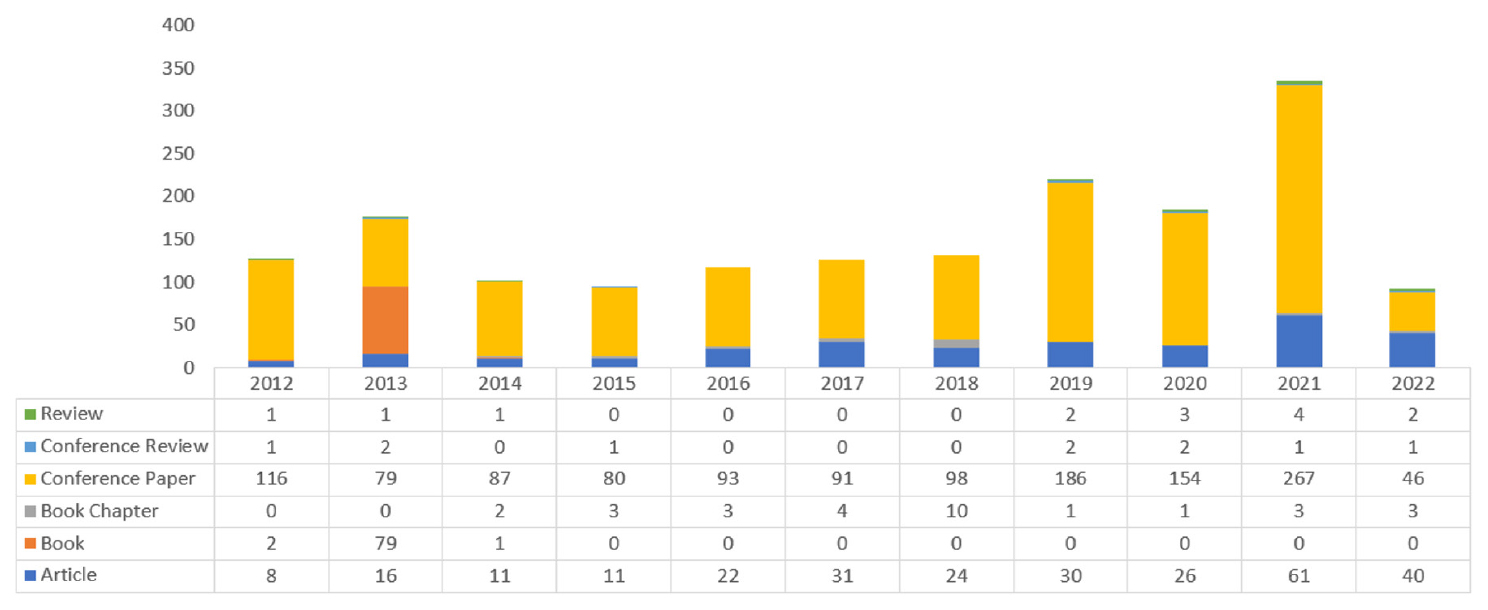
Figure 2:
Data matrix of Scopus database search results on “virtual reality” and “education engineering” for 2012-2022.
The number of studies grew massively in 2021, reaching 336 from 186 the previous year (2020). The worldwide COVID-19 pandemic outbreak is one of the causes of the surge in research between 2020 and 2021. Consequently, numerous scholars are undertaking a study on VR for epidemic-age use, one of which is the implementation in education.[68] That is why there was a significant drop in the data quality in 2022 compared to 2021, 2020, 2019, and 2018. The data may still be improved after updating the public data. According to the information gathered, the number of publications has seen an average annual increase of 44.49%. According to these findings, the time spent researching VR and EE is growing yearly.
Co-Authorship analysis
An author’s collaboration is the interaction in a social context between two or more scientists that facilitates the sharing of meaning and the completion of tasks concerning a mutually shared goal. Authors are motivated to collaborate because of the opportunity to discover new knowledge, increasing specialization within science, the complexity of infrastructure required, and the need to combine various knowledge and skills to address complex health problems. By providing access to different disciplines, the author’s collaboration can also help broaden the scope of a research project and foster innovation. The analysis of co-authorship offers a picture of cooperation patterns between individuals and organizations.[69,70]
According to the data from the author analysis, only 1645 writers out of 4299 authors who have written works on VR and EE have five or more documents linked with their identities. Figure 3 lists the top 10 writers regarding the total number of articles they have written, the total number of citations they have received, and the overall link strength. Li X was the author who generated the most papers, with a total of 17, followed by Wang J, who produced 14 documents, and then Wang Y, Hu W, Li Y, and Zhang X, each of whom contributed 11 documents. The picture also demonstrates that the most significant number of papers does not always correspond to the highest number of citations. It can be observed by comparing the two. It has been shown that Wang J has received the most citations, totaling 353. It is followed by Hu W, who has received 156 citations, and Li X, who has received 155 citations. Figure 3 also represents link strength, which refers to the degree to which connections between authors occur concurrently. The VOSviewer handbook states that each connection has a strength represented by a positive numeric value. The text also states that the strength of the link is proportional to the value. Thus, a more significant value indicates a more vital link. While the overall link strength reveals the number of publications with the same pair of writers simultaneously, each connection’s strength is broken down per publication. According to Figure 3, Ashour O has the most significant overall link strength of 12, which indicates that he has the most research relationships with other scholars. Hu W comes in second with 10, and Zhou H comes in third with 9. The data these statistics provide suggests that there are still plenty of opportunities to collaborate with these authors on VR and EE. According to these findings, a high document count is not necessarily directly related to a high number of citations or a high overall link strength. It was determined by analyzing the relationships between the two variables.
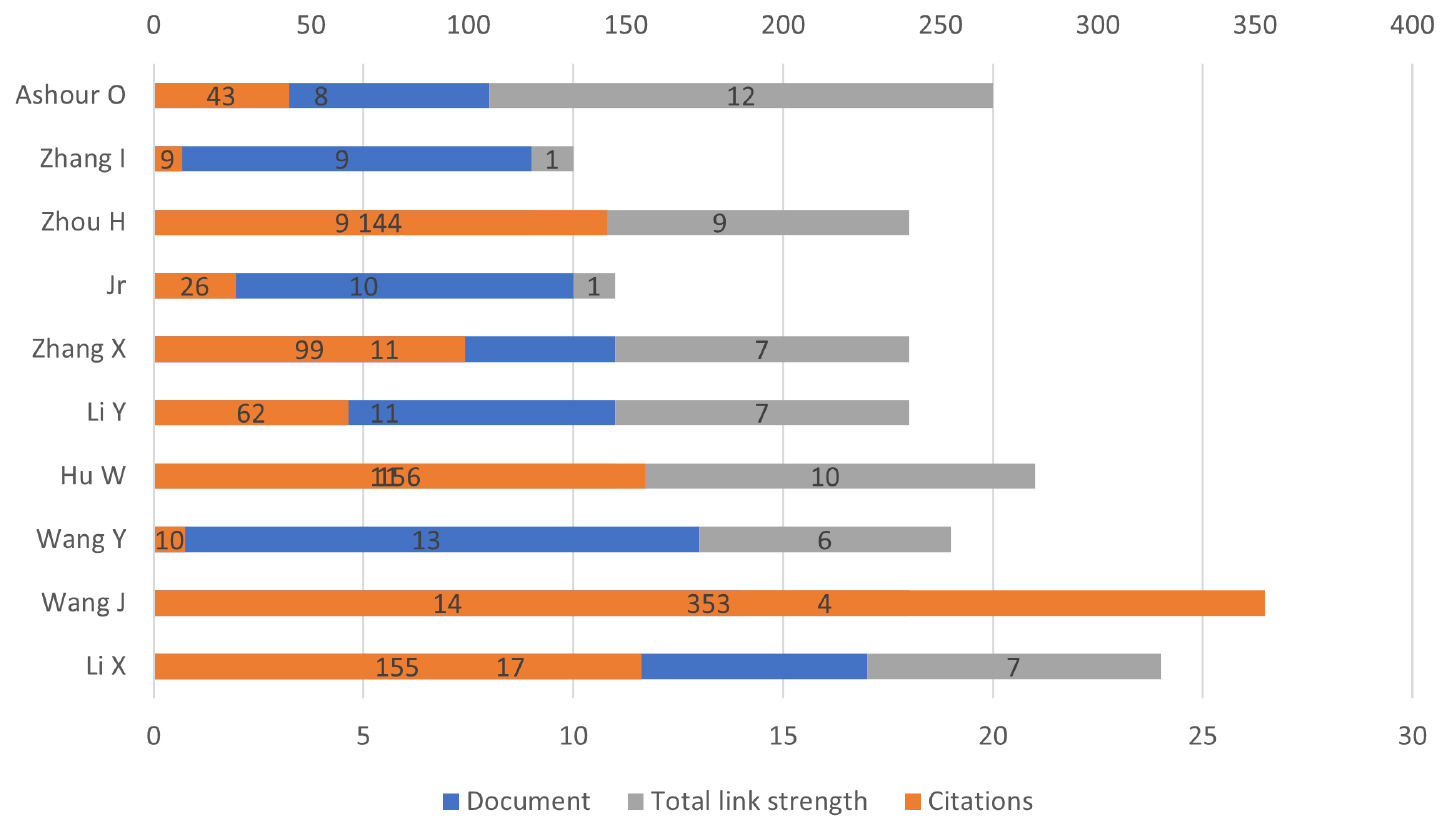
Figure 3:
Top author by number of documents.
Figure 4 indicates that the United Kingdom 4(c) has the most outstanding overall link strength 68, followed by the 4(a) United States with 59, and 4(b) China with 47. It implies that the United Kingdom is one of the most influential nations since it has ties with many countries, yet in terms of documents created, it is not that much when evaluated from the document analysis. It is 84, still inferior to China and the United States. However, when other researchers conduct related investigations, the ensuing works may get more attention.[71,72]

Figure 4:
Visualization of links between countries.
Figure 5 depicts the semantic network of texts regarding the distribution of countries. As can be seen, the People’s Republic of China is the nation that publishes the most regarding VR and EE, with a total of 404 papers (24.5%), followed by the United States of America, with a total of 352 documents (21.4%), and then the United Kingdom with 84 documents (5%). Globally, VR is rapidly becoming the technology of the future. China has identified the VR industry as a critical sector in its innovation plan, and it seeks to become a worldwide leader in technological innovation, adoption, and production. China’s proportion in the global VR market is currently increasing.
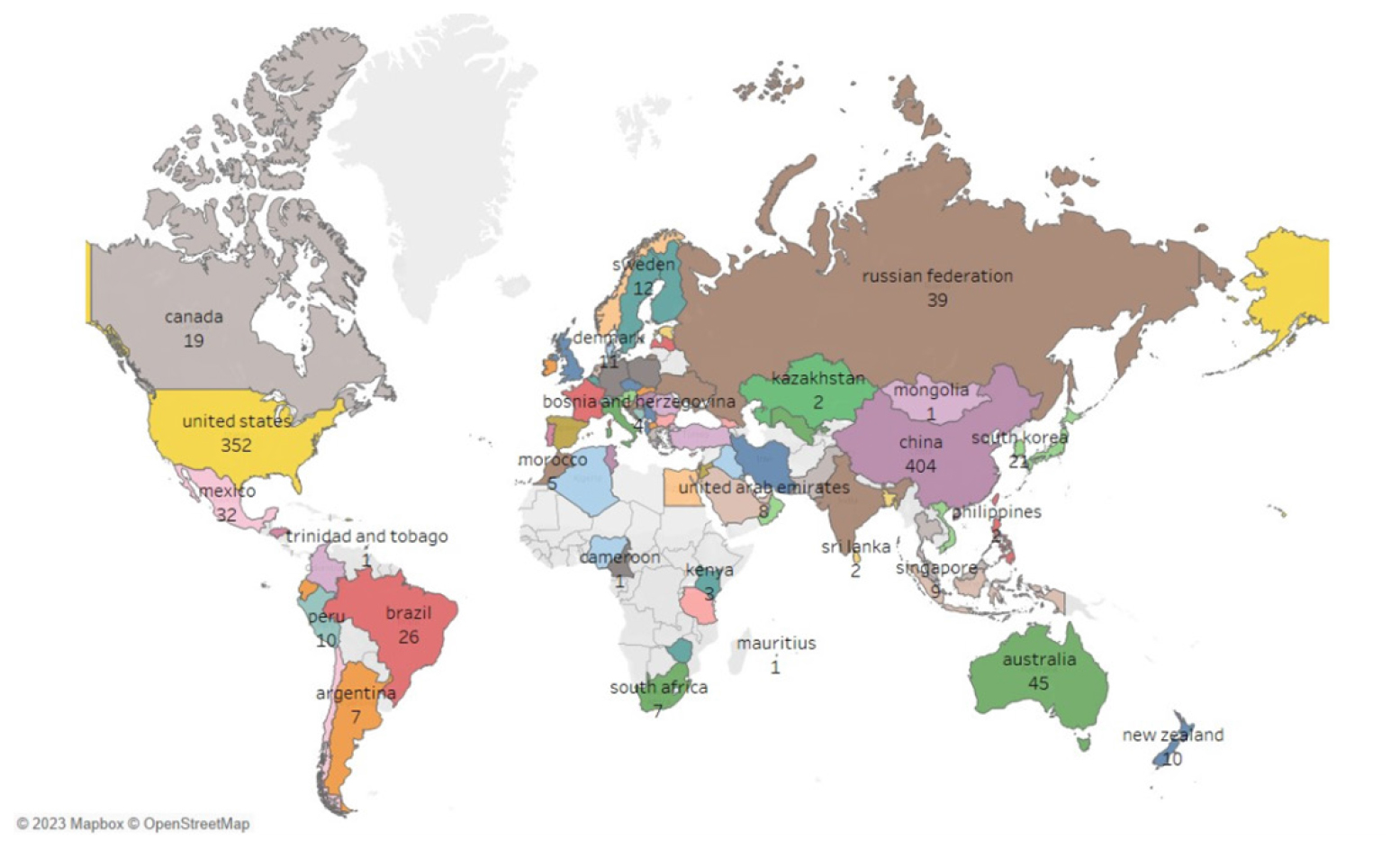
Figure 5:
Distribution visualization of the most productive countries in VR and EE research.
China’s rapid technological growth has led to significant advancements in various fields, including VR technology. This article provides an in-depth review of the developments in VR, encompassing its application across diverse domains such as education, healthcare, manufacturing, and entertainment.[73,40] As a result, the data analyzed by VOSviewer is pertinent to these facts.
This investigation successfully discovered 1645 research institutions or universities actively studying VR and EE as research subjects. Figure 6 displays, in a hierarchical fashion, using a TreeMap, the primary institutions that have produced the most significant number of papers on subjects related to EE and VR. The data’s size and color are interpreted as different numerical dimensions. Five of the best universities may be found in the United States. Tecnologico de Monterrey, which is in Mexico, was the institution that published the most publications, totaling 27. (1.64%). Pennsylvania State University, an American institution, came in second with 24 documents (1.45%), followed by Universidade do Porto, Portugal, with 17 documents (1%), Purdue University, with 16 documents (0.9%), and Wuhan University, China, with 12 documents. All these universities are located in alphabetical order (0.7%). The findings displayed in Figure 5 are supported by the data reported in Table 2.
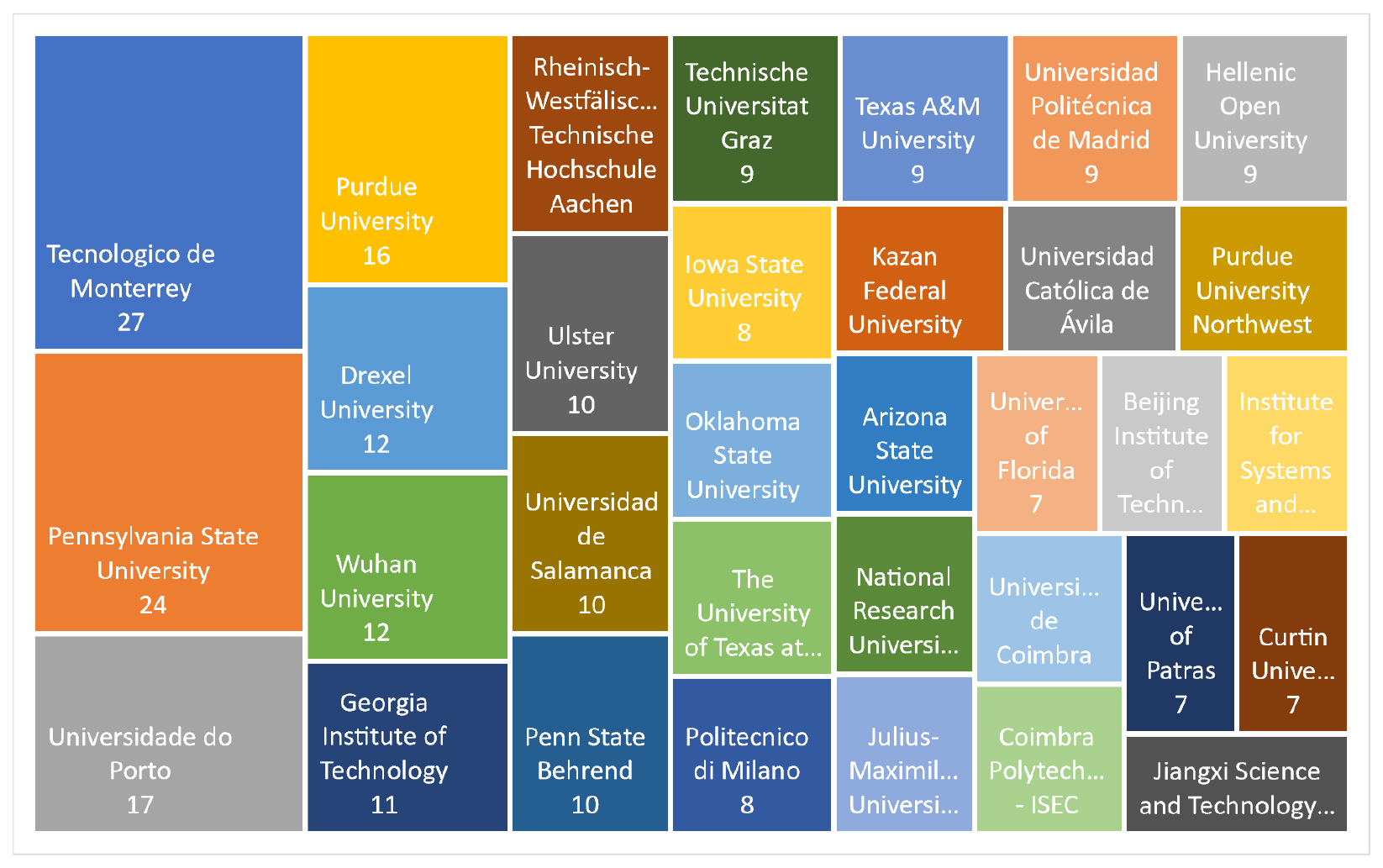
Figure 6:
TreeMap of the top institutions that published the most studies on VR and EE.
| No | University | Country | Citation |
|---|---|---|---|
| 1 | Clemson University | USA | 57 |
| 2 | Pennsylvania State University | USA | 36 |
| 3 | Kazan Federal University, Naberezhnye Chelny | Russian Federation | 24 |
| 4 | American Society for Engineering Education | USA | 19 |
| 5 | Catholic University of Avila | Spain | 18 |
| 6 | Department of Electrical and Computer Engineering, Rowan University | USA | 7 |
| 7 | Drexel University | USA | 4 |
| 8 | Carnegia Mellon University | USA | 3 |
Table 2 shows that six universities in the United States have the most referenced papers, followed by universities in the Russian Federation and Spain. However, when we look at the criteria in Table 2 for the top institutions with the most referenced papers in VR and EE, none of the Chinese universities are in the top ten of the lists because many papers appearing in Chinese journals were initially presented at conferences. However, there is no replacement for “doing it the old-fashioned way” and reading the citing article to see how the reference has been utilized to comprehend how research is being used. The citing paper may refer to it among several grouped references within a literature review (a passing citation), may praise the research’s quality (positive citation), may see the article as influential to a new understanding (citation to a seminal work), may use the research as a benchmark against which to compare their own (comparative citation), or may argue against the research’s findings or methodology (comparative citation) (negative citation). Only by conducting this qualitative review will the researcher be able to determine the level of respect for their research and the true extent of its influence in their field.[74]
The top 5 articles on VR and EE issues are included in Table 3. From 2013 to 2018, the top 5 articles were published. This data shows that the field is growing in this decade. All the articles were on engineering education with different focuses. One paper focused on the challenges of implementing augmented reality in education, two papers discussed virtual laboratories, one paper related to the role of AR/VR/MR in cultural heritage, and one article on the theme of construction engineering education.
| No | Authors | Title | Year | Source Title | Cited by | References |
|---|---|---|---|---|---|---|
| 1 | Wu H.-K., Lee S.W.-Y., Chang H.-Y., Liang J.-C. | Current status, opportunities, and challenges of augmented reality in education. | 2013 | Computers and Education (Q1) | 1033 | [75] |
| 2 | De Jong T., Linn M.C., Zacharia Z.C. | Physical and virtual laboratories in science and engineering education. | 2013 | Science (Q1) | 473 | [76] |
| 3 | Potkonjak V, Gardner M., Callaghan V., Mattila P., Guetl C., Petrović V.M., Jovanović K. | Virtual laboratories for education in science, technology, and engineering: A review. | 2016 | Computers and Education (Q1) | 373 | [77] |
| 4 | Bekele M.K., Pierdicca R., Frontoni E., Malinverni E.S., Gain J. | A survey of augmented, virtual, and mixed reality for cultural heritage. | 2018 | Journal on Computing and Cultural Heritage (Q1) | 278 | [78] |
| 5 | Wang P., Wu P., Wang J., Chi H.-L., Wang X. | A critical review of the use of virtual reality in construction engineering education and training. | 2018 | International Journal of Environmental Research and Public Health (Q1) | 244 | [79] |
The most cited publication (1033) presents an overview of augmented reality’s definition, taxonomy, and technology, a more productive technological idea for educators, researchers, and designers. Although augmented reality (AR) technology is a sophisticated electronic tool, it is not crucial for educational researchers since what is more relevant is how AR may complement and give meaningful learning. This page explains AR. However, it also discusses VR as a more advanced technology than AR.[75] The second most cited article explores physical and virtual labs in education for students to investigate phenomena that cannot be witnessed first-hand owing to distance, risk, and expense. The combination of virtual and actual labs provides maximum learning advantages for students. VR is a less expensive alternative to physical labs.[76] The second most cited article comprehensively analyzes ideas and technology in software-based virtual labs to detect trends and contribute to future studies. This article also gives an opportunity to quickly expand the usage of virtual laboratory-based applications, with the long-term objective of eliminating the necessity for physical labs.[77]
Citation Analysis
When the network connecting the top 10 papers is examined further, it becomes clear that not all the articles are related but rather via documents authored by other writers. The probable explanation is that not all papers featured in the top ten citations are linked, but some are. It demonstrates that the variety of VR applications in EE is still quite wide and needs research. Figure 7(a) depicts a network of the top ten writers exploring VR and EE. Wu H.-K. is the author who has received the most citations.
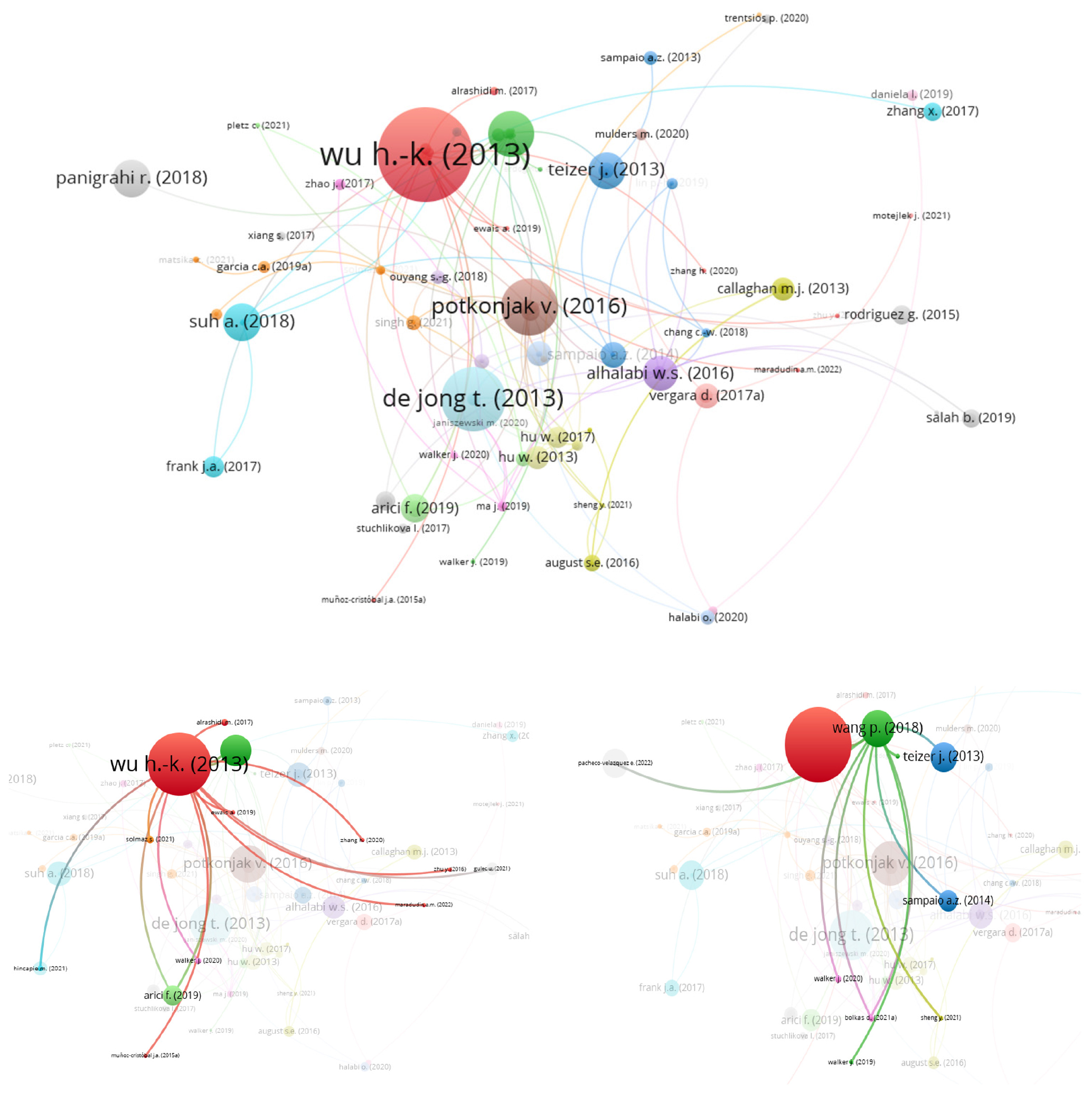
Figure 7:
(a) Network of top 10 authors; (b) The author’s network has the highest number of citations in the first place; (c) The author network with the second highest citation.
Wang, P., Arici, F., Hincapie, M., Munoz Cristobal, J., A., Solmaz, S., Walker, J., Maradudin, M., A., Zhu, Y., Gulec, U., Ewais, A., and Alrashidi, M. have all participated in the collaboration network (Figure 7b).
Meanwhile, Wang, P., the author with the second most citations, collaborates with Wu, H., -K., Teizer, J., Sampaio, A., Z., Walker, J., Bolkas, D., Sheng, Y., and Pacheco-Velasquez, E. These articles give a thorough summary of the research that has been done about VR and EE, as well as the possibilities that may still be developed from these subjects. Because VR has emerged as a prominent subject of discussion within the Education sector, many academics are interested in creating it. This comprehensive and extensive study will support the robust growth of the application of VR in Education. Table 4 shows the data related to Figure 7.
| No | Authors | Title | Cited by | TLS |
|---|---|---|---|---|
| 1 | Wu H.-K., Lee S.W.-Y., Chang H.-Y., Liang J.-C. | Current status, opportunities, and challenges of augmented reality in education. | 1033 | 114 |
| 2 | De Jong T., Linn M.C., Zacharia Z.C. | Physical and virtual laboratories in science and engineering education. | 473 | 38 |
| 3 | Potkonjak V., Gardner M., Callaghan V., Mattila P., Guetl C., Petrović V.M., Jovanović K. | Virtual laboratories for education in science, technology, and engineering: A review. | 373 | 76 |
| 4 | Wang P., Wu P., Wang J., Chi H.-L., Wang X. | A critical review of the use of virtual reality in construction engineering education and training. | 244 | 74 |
Another crucial factor to consider is the number of journal citations to discover relevant areas of study involving VR and EE. Figure 8 shows the top ten journals with the highest number of citations ranked 1 to 5, were Computers and Education (CiteScore 19.8; IF 11.182; Q1) with 1934 citations, Science (CiteScore 57.8; IF 63,714; Q1) with 473 citations, IEEE Global Engineering Education Conference (EDUCON) with 361 citations, Journal on Computing and Cultural Heritage (CiteScore 3.9; IF 1.727; Q1). These statistics may be used to determine if the journal quality factor influences the number of citations. Researchers are more inclined to seek out reputable publications to reference. The top 20 papers include 14 from Q1 journals and one from Q2, with the remainder indexed by Scopus.
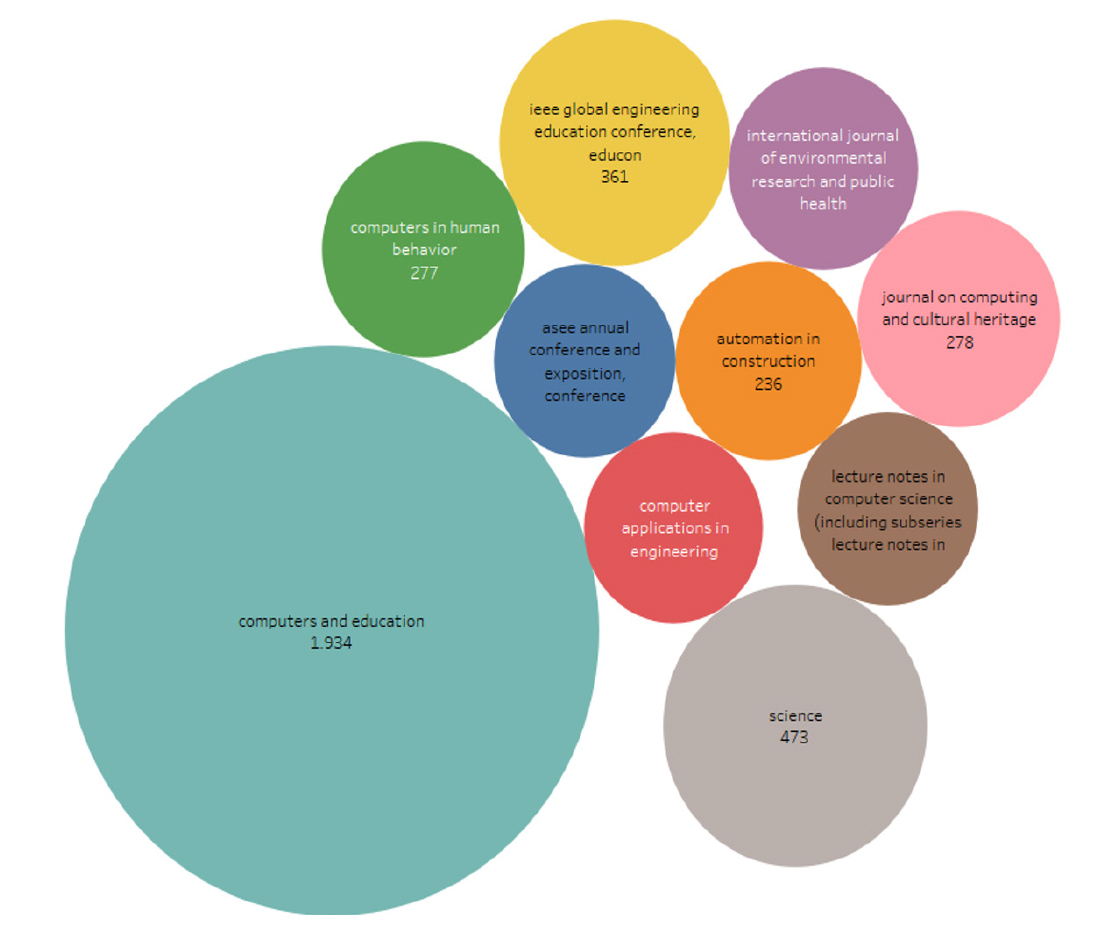
Figure 8:
Top 10 Journals with the most citations.
Keywords Co-Occurrence Analysis
Co-occurrence displays a visualization of the network between keywords. At least this is Keyword Co-Occurrence Analysis because Co-Authorship analysis is also Co-Occurrence Analysis, but only for Co-Authors. We created a map of the most frequently occurring keywords shown in Figure 9. As illustrated in Figure 9, those keywords were classified into five groups. Clustering in VOSviewer is based on minimizing distances between keywords, i.e., the most related keywords fall into one cluster.[80] As a result, the five closest keywords in those five clusters are (1) virtual reality, (2) virtual reality technology, (3) virtual worlds, (4) education, and (5) STEM (science, technology, engineering, and mathematics). According to preliminary conclusions, the first cluster represents the user’s needs, and the second represents knowledge representation.
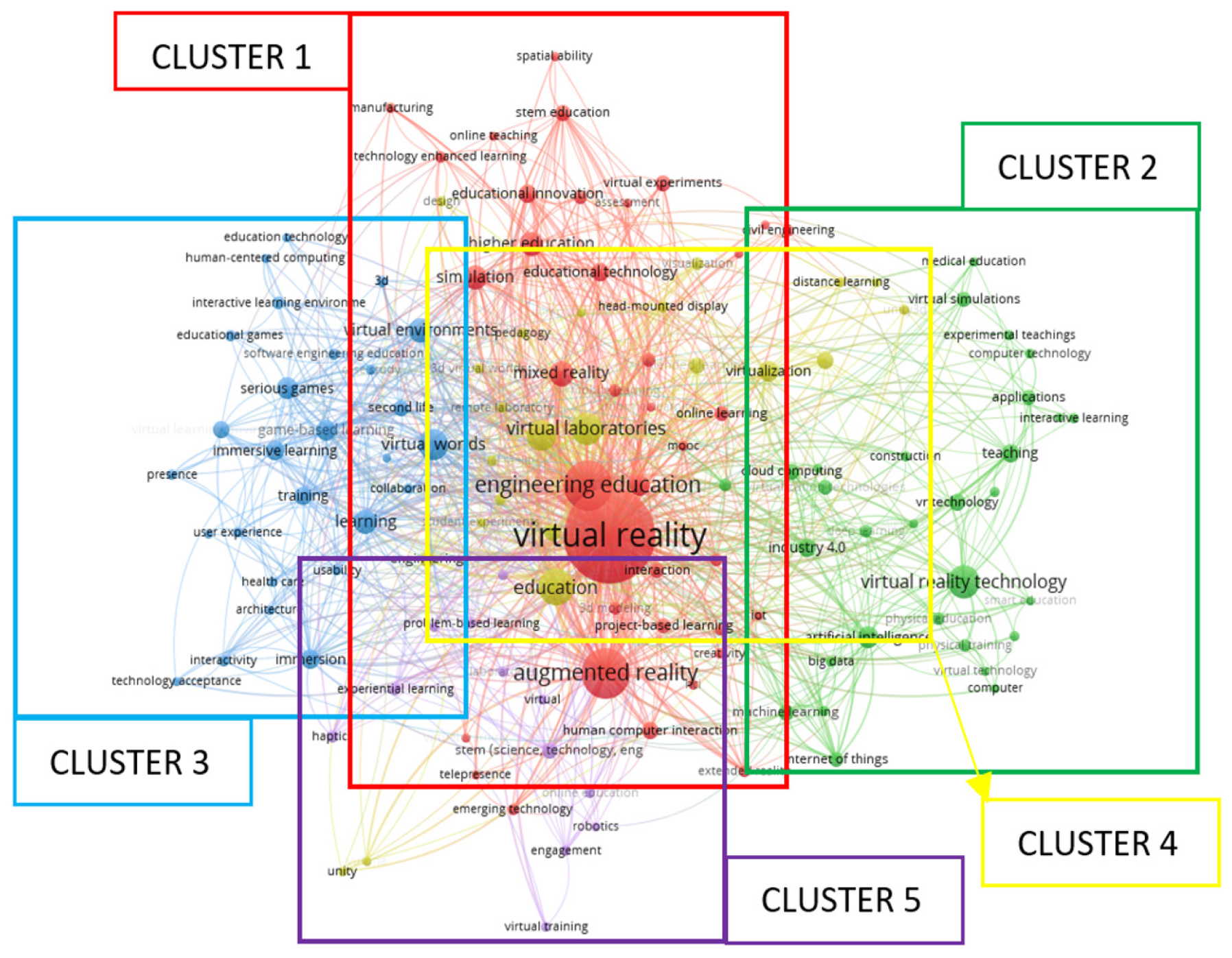
Figure 9:
Visualization of co-occurrence clusters based on author keywords for VR and EE.
Based on author keywords, five clusters were created to show the network visualization between VR and EE keywords. The clusters represent two distinct research streams. The formation of clusters shows the VR and electronic engineering trends, which illustrate the development of distinct keywords for each cluster. Initially, the most important term is “virtual reality” in cluster 1, highlighted in red. The most common keywords are engineering education, mixed reality, educational technology, simulation, and augmented reality, which are all related. VR and related technologies, such as mixed and augmented reality, dominate this term cluster.
Additionally, it has to do with VR in engineering education, technology education, and educational simulations. VR is a device that students wear, which means that, especially in the current climate, the concept of a classroom set of VR headsets may become obsolete. Instead, VR has gained popularity as a tool for distance education and home study. It might play a critical role in a post-device era “where digital technology use diversifies beyond the dominance of laptop/tablet/smartphone use”.[81,82]
As for the second section, shaded green and called cluster 2, VR is the most often used word. Topics covered in this cluster include VR implementation for AI, the Internet of Things (IoT), cloud computing, machine learning, and other aspects of information technology (IT). Cluster 2 and VR-based technical applications have a good link. VR is still in its early phases of development and faces several challenges. Because technology is not fully integrated into the virtual environment, many virtual devices must be connected to the computer via cables. Many movements in the body cannot be mimicked in a virtual environment because most VR equipment only tracks the head. Dizziness and exhaustion are common side effects of using cameras in VR because of the constantly shifting focal locations. As a result, many of the gadgets are cumbersome and awkward. Since these issues are primarily technical, companies and academic institutions must increase their R&D efforts to help advance virtual reality technology. VR is currently used in education, design, development, smart cities, architecture, the industrial sector, tourism, and theme parks, among other areas.[83]
Virtual worlds are the most often appearing terms in Cluster 3, and five primary keywords accompany them: educational games, serious games, training, learning, and game-based learning. This cluster focuses on game-based VR for learning and teaching. The creation of game models has piqued the interest of many academics in engineering education. Because it is easy to grasp, the game method has also started to be extensively developed for the training area. Virtual worlds allow faculty to shift from a teacher-centered to a learner-centered model of instruction. They also provide educators an excellent opportunity to implement learner-centered pedagogies that promote active, constructivist, inquiry, or problem-based learning. Students are active in the learning process and are constantly involved in it through their experiences. Virtual worlds allow people to interact in ways that lack a sense of presence in other forms of media.[84,85]
Education is the most often used term in Cluster 4, with five primary keywords: virtual labs, virtualization, remote laboratory, student experiments, and integrated learning. This cluster is concerned with laboratory learning using virtual and remote models, closely connected to blended learning. VR in laboratory implementation seems to be a future alternative for higher education institutions to strengthen their students’ competency so that laboratory accessibility may be attained remotely. VR education supports learning and teaching and uses technical and pedagogical methods and techniques. It is the foundation for the recent e-learning revolution’s success. Technology-based teaching can provide a wide range of affordability and capabilities that can improve motivation and lead to engaging, efficient, and effective learning beyond traditional classroom-based teaching in terms of quality.[86]
STEM is the most often used term in Cluster 5, along with five other essential keywords: virtual learning, online education, problem-based learning, experiential learning, and robotics. This cluster emphasizes STEM subjects where VR may be used as an alternate medium for learning. Due to their immersive qualities, capacity to transmit knowledge in novel and engaging ways, and potential to provide virtual experiences that can reduce barriers from cost or distance, AR/VR technologies are a promising addition to the “edtech” area. Although it is still in its early phases, many encouraging examples of this technology are already being used in K-12, higher education, and teacher preparation. Applications span the humanities and arts and technical training in STEM fields. K-12 instructors may benefit from dynamic and captivating AR/VR solutions for the classroom. These include immersive content libraries, activities tailored to specific topics or learning goals, and resources for students who struggle with learning. AR/VR can help learners grasp abstract concepts in higher education and gain hands-on experience in low-risk virtual settings. It can enhance STEM courses, medical simulations, arts and humanities materials, and technical education. The government should direct the Department of Education to invest in programs, resources, and initiatives to guide the development of AR/VR educational solutions and encourage further innovations in this field.[87]
Investigating the keywords used in these studies is a great starting point in examining their evolution. This study sums up the evolution of global research trends in VR and EE. The focus on the authors and their accomplishments was categorized by keywords, providing general ideas about research trends. Among the five keyword clusters “virtual reality,” “virtual reality technology,” “virtual worlds,” “education,” and “STEM (science, technology, engineering, and mathematics),” the latter is of specific interest due to its increased use in the last couple of years. Consequently, reviewing the highly cited fixation-related articles was necessary to understand their points of interest.
VOSviewer may also investigate the year of co-occurrence of terms. The co-occurrence chronology of keywords can clearly illustrate the moment of the first co-occurrence of terms, which will aid in understanding the study around VR and EE. Figure 10 depicts a historical picture of the co-occurrence. The hue of the line in the illustration between the keywords corresponds to the moment they first appeared together. The more occurrences of the two keywords appear with a thicker line. The more intense the two instances of a term are together. The blue hue nodes in Figure 9 show popular or often-used terms, but the yellowish nodes describe the trend or popularity of a more recent study that many other scholars have not done. Some subjects that may be utilized as study trends are based on the findings of the VOSviewer overlay visualization.
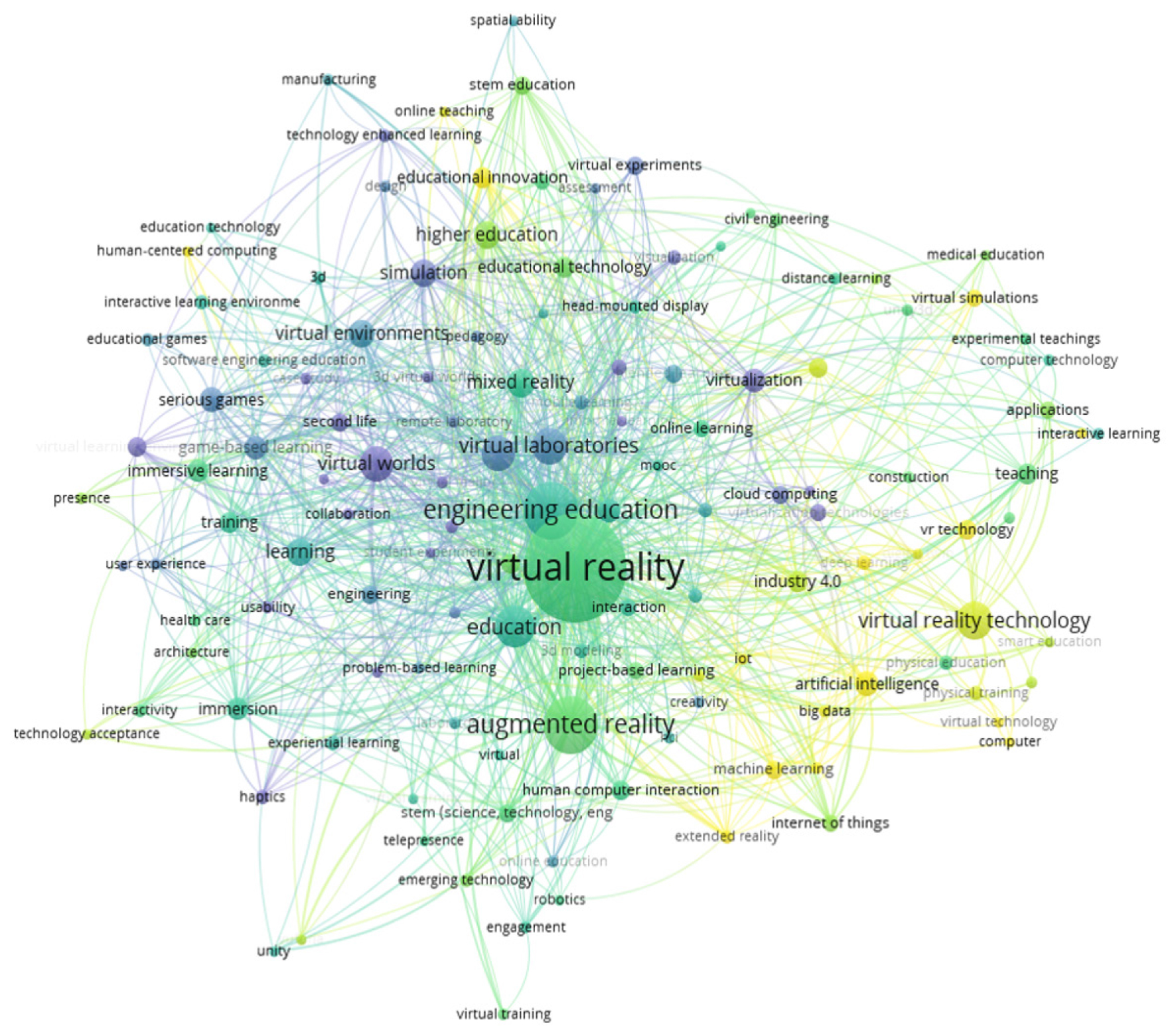
Figure 10:
Overlay visualization for author keywords with VR and EE topics.
Under the author’s terms, the overlay visualization presents a plethora of potential avenues for the advancement of study; it originates from the yellow node seen in Figure 11. In Figure 11(a), the keyword “vr technology” is connected to many different networks; however, the relationship between deep learning and artificial intelligence is shown to have a yellow color, which indicates that there has been very little progress made in the field of VR if it is associated with either of these two concepts. According to a search conducted in the Scopus database using the terms “vr technology” AND “deep learning,” 32 articles were produced between 2018 and 2022. In this era of big data and deep learning, the 32 most popular and extensively referenced articles illustrate the advantages of using VR technology to visualize geological and mineral data. It allows for the generation of new insights into underwater mining exploration. There is widespread availability of limitless data streams, and these geology, geochemistry, and geophysics monitoring systems will even be automated.[88] The following article, mentioned 22 times, described the findings of a study on cybersickness caused by crosstalk between sensory and cognitive systems. However, since sensory and cognitive processes cannot be examined objectively, measuring cyber illness is problematic. This method is used to detect cybersickness using EEG (Electro Encephalo Graphy) data, deep learning methods (Deep Neural Network/DNN), and Convolutional Neural Network (CNN) are utilized. The study’s findings reflect the overall pattern that causes cybersickness.[89]
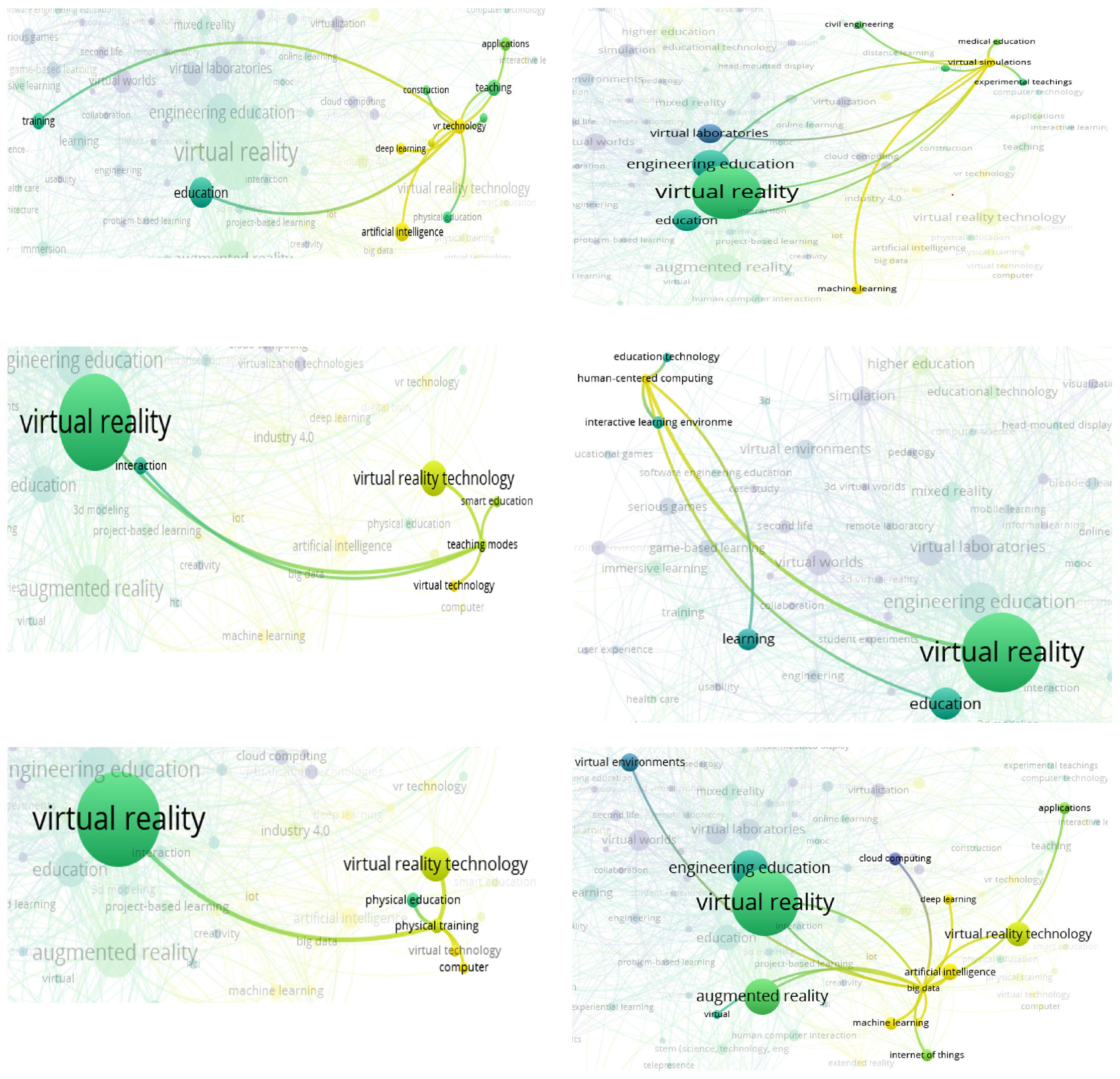
Figure 11:
Highlight keywords in (a) vr technology, (b) teaching modes, (c) physical training, (d) virtual simulation, (e) human-centered computing, (f) Artificial intelligence.
Figure 11(b) depicts a network that is still relatively modest; a Scopus search with the keywords “teaching modes” AND “smart education” produced 12 pages. These publications were published between 2020 and 2022, indicating that this area is still under-researched, making it a fascinating innovation to explore. Articles with as much as one reference describe the influence of COVID-19 on advancing the development of educational information systems and enhancing the integration and use of digitalization in education. Smart classrooms, as a crucial component of intelligent education, are projected to impact education and teaching significantly. To be more specific, the process entails storing data in the cloud, intelligent pushing, asking questions, creating scenarios, establishing individual learning modes, combining online teaching methods with collaborative learning modes, providing quantitative results based on collaborative learning status, and finally conducting evaluation feedback and knowledge extension after class.[90]
Figure 11(c) illustrates that the network with tremendous development potential is connected to physical exercise. Scopus search results for the keywords “physical training” AND “virtual reality technology” yielded 33 documents. The article with the most citations, published in 2018, demonstrates the research of VR technology for training applications since it is necessary to analyze its validity compared to conventional teaching formats. The study’s findings indicate that trainee performance is highly relevant.[91] Furthermore, the yellow node in Figure 11(d) discusses virtual simulation with machine learning. From Scopus search results for the keywords “virtual simulation” AND “machine learning,” 45 publications with the highest citations were discovered, 43 of which were produced in 2019. The article covers self-driving cars as a critical component of future intelligent transportation systems. This paper describes a two-part training and decision-making learning framework: a DRL training program and a high-fidelity virtual simulation environment.[92] It is possible to interpret the information shown in Figure 11(d) as indicating that the educational component is still very little or nearly nothing connected to virtual simulation and machine learning.
The human-centered computer network shown in Figure 11(e) has education as its primary focus. A total of 136 items were found after searching “human-centered computing” and “education.” The concept of learning scenario models to give contextual services, which this research covers, is described in detail in a paper that has received 139 citations. To model human behavior in intelligent settings, a scenario model specifies the environment, users, and the activities they use.[93] The following article, which has 56 citations, offers vital insights into creating and assessing interpersonal simulators. These are systems that allow interpersonal interactions with virtual persons. The paper gives critical insights into these topics. Two studies compared virtual humans’ interactions with similar real humans when using simulators. The specific interpersonal scenario used is a medical interview. Medical students interact with virtual humans simulating appendicitis or real humans pretending to have the same symptoms. Nonverbal behavior appears to communicate lower interest and poorer attitudes toward virtual humans. Several subjective measures of participant behavior yielded contradictory results, highlighting the need for objective, physical-based measures in future studies.[94]
Finally, Figure 11(f) depicts artificial intelligence and machine learning networks that are still yellow. Scopus search results for the keywords “artificial intelligence” AND “machine learning” yielded seven documents. Six of the seven texts are articles on topics unrelated to education but broader, such as computer vision and machine learning (2007 with 14 citations),[95] predictions on Drug-Drug Interactions (DDIs) (2015 with /9 citations, using our radiological ground truth for future development on binary glioma grading (2021 with two citations), artificial intelligence in healthcare (2021 with 0 citations), identifying Chemical-Induced Disease (CID) relations (2017 with 0 citations), and one paper related to education about exploration machine learning for automatic semantic feature assignment (2017/0 citations).[96] This data suggests that there are still numerous options for study subjects that may be conducted using keywords linked to artificial intelligence, machine learning, and VR.
CONCLUSION
This study outlines the primary subjects explored in recent years in research in VR and EE. The trend that has resulted from this growth is the continual increase in papers related to EE and VR every year. It suggests that researchers are showing a growing interest in studying this subject. The potential for a COVID-19 virus-related pandemic also contributes to this research’s growth between 2020 and 2021. It is fascinating that many researchers are conducting research during this phase to contribute to electrical engineering using a VR technology approach. It is being done to ensure that the learning process can still be done even while the pandemic is in progress. With 24.5% of the total papers generated by Scopus, China is the country that has made the most significant contribution to research in this sector. Hsin-Kai Wu, Silvia Wen-Yu Lee, Hsin-Yi Chang, and Jyh-Chong Liang, all of whom were based in Taiwan and had articles published in the Journal of Computers and Education, were the writers who received the most citations.
The keyword analysis results allowed the writers to discover a few critical subjects that other researchers have not thoroughly researched up to this time. Five core keywords will become future research trends, and they are as follows: virtual reality, virtual reality technology, virtual worlds, education, and STEM. These five keywords derive from the five clusters (science, technology, engineering, and mathematics). When the networks within each cluster were investigated more deeply, topics related to teaching modes, physical training, virtual simulation, human-centered computing, artificial intelligence, innovative education, deep learning, cybersickness, sensory and cognitive systems, physical training, virtual simulation, machine learning, human-centered computing, and artificial intelligence in education were found. Innovative education refers to the use of artificial intelligence in the classroom. Therefore, it is vital to step up research and development activities on VR for EE to meet the difficulties of expanding digital technology’s role in education. Increasing the quantity of research supported by VR research in the educational sector is essential. The expansion of cooperation networks between researchers working in educational institutions and universities in various nations will also have an influence that may be felt on the education system in every region of the globe.
VR technology that allows for the interactive and immersive depiction of three-dimensional space is a developing technology that shows promise in EE and training. It represents a tool that may be used to construct a pipeline for collaboration with industry to equip the next generation of graduate engineers with the abilities necessary for business. The authors show how real-world practical case studies can showcase how cutting-edge technology may generate creative learning and training engineering materials and environments. The chosen technology in research and teaching lives up to the standards set by the most cutting-edge student generation. Even though it is widely acknowledged that cost is a primary obstacle, many of the world’s preeminent educational establishments have already deployed technology for research and instruction. On the other hand, costs are expected to decrease in tandem with further technological progress. Therefore, it is anticipated that different institutions will implement the requisite hardware and software levels for VR to be strategically used in EE in the foreseeable future.
Cite this article:
Rafiq AA. Engineering Education’s Potential for Virtual Reality Research and Development from 2012-2022: A Bibliometric Study. J Scientometric Res. 2024;13(1):317-332.
ACKNOWLEDGEMENT
The authors thank the Indonesia Endowment Fund for Education (LPDP) from the Ministry of Finance, the Republic of Indonesia, for granting the scholarship and supporting this research.
References
- Dalgarno B, Lee MJ. What are the learning affordances of 3-D virtual environments?. Brit J Educational Tech. 2010;41(1):10-32. [CrossRef] | [Google Scholar]
- Garzón J, Pavón J, Baldiris S. Systematic review and meta-analysis of augmented reality in educational settings. Virtual Real. 2019;23(4):447-59. [CrossRef] | [Google Scholar]
- Karabulut-Ilgu A, Jaramillo Cherrez N, Jahren CT. A systematic review of research on the flipped learning method in engineering education. Brit J Educational Tech. 2018;49(3):398-411. [CrossRef] | [Google Scholar]
- Boelt AM, Kolmos A, Holgaard JE. Literature review of students’ perceptions of generic competence development in problem-based learning in engineering education. Eur J Eng Educ. 2022;47(6):1399-420. [CrossRef] | [Google Scholar]
- Akçayır M, Akçayır G. Advantages and challenges associated with augmented reality for education: A systematic review of the literature. Educ Res Rev. 2017;20:1-11. [CrossRef] | [Google Scholar]
- Jensen L, Konradsen F. A review of the use of virtual reality head-mounted displays in education and training. Educ Inf Technol. 2018;23(4):1515-29. [CrossRef] | [Google Scholar]
- Flavián C, Ibáñez-Sánchez S, Orús C. The influence of scent on virtual reality experiences: the role of aroma-content congruence. J Bus Res. 2021;123:289-301. [CrossRef] | [Google Scholar]
- Serrano B, Baños RM, Botella C. Virtual reality and stimulation of touch and smell for inducing relaxation: A randomized controlled trial. Comput Hum Behav. 2016;55:1-8. [CrossRef] | [Google Scholar]
- Auld LWS, Pantelidis VS. Exploring virtual reality for classroom use – the virtual reality and education lab at East Carolina University. TechTrends. 1994;39(1):29-31. [CrossRef] | [Google Scholar]
- Pantelidis VS. Reasons to use virtual reality in education and training courses and a model to determine when to use virtual reality. Themes Sci Technol Educ. 2010;2((1-2)):59-70. [CrossRef] | [Google Scholar]
- Harris DJ, Buckingham G, Wilson MR, Vine SJ. Virtually the same? How impaired sensory information in virtual reality may disrupt vision for action. Exp Brain Res. 2019;237(11):2761-6. [PubMed] | [CrossRef] | [Google Scholar]
- Bourhim EM, Cherkaoui A. Efficacy of virtual reality for studying People’s pre-evacuation behavior under fire. Int J Hum Comput Stud. 2020;142 [CrossRef] | [Google Scholar]
- Morélot S, Garrigou A, Dedieu J, N’Kaoua B. Virtual reality for fire safety training: influence of immersion and sense of presence on conceptual and procedural acquisition. Comput Educ. 2021;166 [CrossRef] | [Google Scholar]
- Fowler C. Virtual reality and learning: where is the pedagogy?. Brit J Educational Tech. 2015;46(2):412-22. [CrossRef] | [Google Scholar]
- Luo H, Li G, Feng Q, Yang Y, Zuo M. Virtual reality in K-12 and higher education: A systematic review of the literature from 2000 to 2019. J Comput Assist Learn. 2021;37(3):887-901. [CrossRef] | [Google Scholar]
- Mulders M, Buchner J, Kerres M. A framework for the use of immersive virtual reality in learning environments. Int J Emerg Technol Learn. 2020;15(24):208-24. [CrossRef] | [Google Scholar]
- Chen B, Wang Y, Wang L. The effects of virtual reality-assisted language learning: A meta-analysis. Sustain. 2022;14(6) [CrossRef] | [Google Scholar]
- Li C, Ip HHS. Defining Virtual Reality enabled Learning. Int J Innov Learn. 2022;31(3):1 [CrossRef] | [Google Scholar]
- Makransky G, Andreasen NK, Baceviciute S, Mayer RE. Immersive virtual reality increases liking but not learning with a science simulation and generative learning strategies promote learning in immersive virtual reality. J Educ Psychol. 2021;113(4):719-35. [CrossRef] | [Google Scholar]
- Petersen GB, Klingenberg S, Mayer RE, Makransky G. The virtual field trip: investigating how to optimize immersive virtual learning in climate change education. Br J Educ Technol. 2020;51(6):2098-114. [CrossRef] | [Google Scholar]
- Daniela L, Lytras MD. Editorial: themed issue on enhanced educational experience in virtual and augmented reality. Virtual Real. 2019;23(4):325-7. [CrossRef] | [Google Scholar]
- Christopoulos A, Conrad M, Shukla M. Increasing student engagement through virtual interactions: how?. Virtual Real. 2018;22(4):353-69. [CrossRef] | [Google Scholar]
- Meyer OA, Omdahl MK, Makransky G. Investigating the effect of pre-training when learning through immersive virtual reality and video: A media and methods experiment. Comput Educ. 2019;140 [CrossRef] | [Google Scholar]
- Checa D, Bustillo A. Advantages and limits of virtual reality in learning processes: Briviesca in the fifteenth century. Virtual Real. 2020;24(1):151-61. [CrossRef] | [Google Scholar]
- Thisgaard M, Makransky G. Virtual learning simulations in high school: effects on cognitive and non-cognitive outcomes and implications on the development of STEM academic and career choice. Front Psychol. 2017;8:805 [PubMed] | [CrossRef] | [Google Scholar]
- Allcoat D, von Mühlenen A. Learning in virtual reality: effects on performance, emotion and engagement. Res Learn Technol. 2018;26 [CrossRef] | [Google Scholar]
- yue QX, Chiu CK, Zhao LL, Sun CF, jie Chen S. Trends in VR/AR technology-supporting language learning from 2008 to 2019: a research perspective. Interact Learn Environ. 2021:1-24. [CrossRef] | [Google Scholar]
- Papanastasiou G, Drigas A, Skianis C, Lytras M, Papanastasiou E. Virtual and augmented reality effects on K-12, higher and tertiary education students’ twenty-first century skills. Virtual Real. 2019;23(4):425-36. [CrossRef] | [Google Scholar]
- Marks B, Thomas J. Adoption of virtual reality technology in higher education: an evaluation of five teaching semesters in a purpose-designed laboratory. Educ Inf Technol (Dordr). 2022;27(1):1287-305. [PubMed] | [CrossRef] | [Google Scholar]
- Baxter G, Hainey T. Student perceptions of virtual reality use in higher education. J Appl Res High Educ. 2020;12(3):413-24. [PubMed] | [CrossRef] | [Google Scholar]
- Johnston E, Olivas G, Steele P, Smith C, Bailey L. Exploring pedagogical foundations of existing virtual reality educational applications: A content analysis study. J Educ Technol Syst. 2018;46(4):414-39. [CrossRef] | [Google Scholar]
- Radianti J, Majchrzak TA, Fromm J, Wohlgenannt I. A systematic review of immersive virtual reality applications for higher education: design elements, lessons learned, and research agenda. Comput Educ. 2020;147 [CrossRef] | [Google Scholar]
- Kustandi C, Fadhillah DN, Situmorang R, Prawiladilaga DS, Hartati S. VR use in online learning for higher education in Indonesia. Int J Interact Mob Technol. 2020;14(1):31-47. [CrossRef] | [Google Scholar]
- Ghrairi N, Kpodjedo S, Barrak A, Petrillo F, Khomh F. The State of practice on virtual reality (VR) applications: an exploratory study on GitHub and stack overflow. 2018:356-66. [CrossRef] | [Google Scholar]
- García-Vela M, Zambrano J, Falquez DA, Pincay-Musso W, Duque K, Zumba N, et al. Management of virtual laboratory experiments in the geosciences field in the time of Covid-19 Pandemic. ICERI Proceedings. 2020;1:8702-11. [CrossRef] | [Google Scholar]
- Makransky G, Mayer RE, Veitch N, Hood M, Christensen KB, Gadegaard H, et al. Equivalence of using a desktop virtual reality science simulation at home and in class. PLOS ONE. 2019;14(4):e0214944 [PubMed] | [CrossRef] | [Google Scholar]
- Chan P, Van Gerven T, Dubois J-L, Bernaerts K. Virtual chemical laboratories: A systematic literature review of research, technologies and instructional design. Comput Educ Open. 2021;2 [CrossRef] | [Google Scholar]
- Kamińska D, Sapiński T, Wiak S, Tikk T, Haamer RE, Avots E, et al. Virtual reality and its applications in education: survey. Information. 2019;10(10):1-20. [CrossRef] | [Google Scholar]
- Inamura T, Mizuchi Y. SIGVerse: A cloud-based VR platform for research on multimodal human-robot interaction. Front Robot AI. 2021;8 [PubMed] | [CrossRef] | [Google Scholar]
- Smutny P. Learning with virtual reality: a market analysis of educational and training applications. Interact Learn Environ. 2022:1-14. [CrossRef] | [Google Scholar]
- Perez-Ramirez M, Arroyo-Figueroa G, Ayala A. The use of a virtual reality training system to improve technical skill in the maintenance of live-line power distribution networks. Interactive Learning Environments. 2021;29(4):527-44. [CrossRef] | [Google Scholar]
- Román-Ibáñez V, Pujol-López FA, Mora-Mora H, Pertegal-Felices ML, Jimeno-Morenilla A. A low-cost immersive virtual reality system for teaching robotic manipulators programming. Sustainability. 2018;10(4) [CrossRef] | [Google Scholar]
- Valdez MT, Ferreira CM, Maciel Barbosa FPM. Distance education using a desktop virtual reality (VR) system. 2013:145-50. [CrossRef] | [Google Scholar]
- Allcoat D, Hatchard T, Azmat F, Stansfield K, Watson D, von Mühlenen A, et al. Education in the digital age: learning experience in virtual and mixed realities. J Educ Comput Res. 2021;59(5):795-816. [CrossRef] | [Google Scholar]
- Ellegaard O, Wallin JA. The bibliometric analysis of scholarly production: how great is the impact?. Scientometrics. 2015;105(3):1809-31. [PubMed] | [CrossRef] | [Google Scholar]
- Szomszor M, Adams J, Fry R, Gebert C, Pendlebury DA, Potter RWK, et al. Interpreting bibliometric data. Front Res Metr Anal. 2021;5:1-20. [PubMed] | [CrossRef] | [Google Scholar]
- Snyder H. Literature review as a research methodology: an overview and guidelines. J Bus Res. 2019;104(March):333-9. [CrossRef] | [Google Scholar]
- Linnenluecke MK, Marrone M, Singh AK. Conducting systematic literature reviews and bibliometric analyses. Aust J Manag. 2020;45(2):175-94. [CrossRef] | [Google Scholar]
- Rogers G, Szomszor M, Adams J. Sample size in bibliometric analysis. Scientometrics. 2020;125(1):777-94. [CrossRef] | [Google Scholar]
- Musa TH, Musa IH, Osman W, Campbell MC, Musa HH. A bibliometric analysis of global scientific research output on gum arabic. Bioact Carbohydr Diet Fibre. 2021;25 [CrossRef] | [Google Scholar]
- Christ-Ribeiro A, Chiattoni LM, Mafaldo CRF, Badiale-Furlong E, de Souza-Soares LA. Fermented rice-bran by Saccharomyces cerevisiae: nutritious ingredient in the formulation of gluten-free cookies. Food Biosci. 2021;40 [CrossRef] | [Google Scholar]
- Hincapie M, Diaz C, Valencia A, Contero M, Güemes-Castorena D. Educational applications of augmented reality: A bibliometric study. Comput Electr Eng. 2021;93 [CrossRef] | [Google Scholar]
- Zyoud SH, Zyoud AH. Visualization and mapping of knowledge and science landscapes in expert systems with applications Journal: A 30 years’ bibliometric analysis. SAGE Open. 2021;11(2) [CrossRef] | [Google Scholar]
- Santisteban-espejo A, Moral-munoz JA, Campos A. Martin-piedra MA. Array. 2020;143 [CrossRef] | [Google Scholar]
- Brimo Alsaman MZ, Sallah H, Badawi R, Ghawi A, Shashaa MN, Kassem LH, et al. Syrian medical, dental and pharmaceutical publication in the last decade: A bibliometric analysis. Ann Med Surg (Lond). 2021;66 [PubMed] | [CrossRef] | [Google Scholar]
- Goksu I. Bibliometric mapping of mobile learning. Telemat Inform. 2021;56 [CrossRef] | [Google Scholar]
- Donthu N, Kumar S, Pandey N, Gupta P. Forty years of the International Journal of Information Management: A bibliometric analysis. Int J Inf Manag. 2021;57 [CrossRef] | [Google Scholar]
- Saleem F, Khattak A, Ur Rehman S, Ashiq M. Bibliometric analysis of green marketing research from 1977 to 2020. Publications. 2021;9(1):1-19. [CrossRef] | [Google Scholar]
- Persson O. Bibexcel is a versatile bibliometric toolbox developed. Inflibnet. 2016;23(4) [CrossRef] | [Google Scholar]
- Palácios H, de Almeida MH, Sousa MJ. A bibliometric analysis of trust in the field of hospitality and tourism. Int J Hosp Manag. 2021:95 [CrossRef] | [Google Scholar]
- Verma S, Gustafsson A. Investigating the emerging COVID-19 research trends in the field of business and management: A bibliometric analysis approach. J Bus Res. 2020;118:253-61. [PubMed] | [CrossRef] | [Google Scholar]
- van Eck NJ, Waltman L. Software survey: VOSviewer, a computer program for bibliometric mapping. Scientometrics. 2010;84(2):523-38. [PubMed] | [CrossRef] | [Google Scholar]
- Méndez E, Crestani F, Ribeiro C, David G, Lopes JC. Digital Libraries for Open Knowledge. 2018 [PubMed] | [CrossRef] | [Google Scholar]
- Skaf L, Buonocore E, Dumontet S, Capone R, Franzese PP. Applying network analysis to explore the global scientific literature on food security. Ecol Inform. 2020;56 [CrossRef] | [Google Scholar]
- Perianes-Rodriguez A, Waltman L, van Eck NJ. Constructing bibliometric networks: A comparison between full and fractional counting. J Informetr. 2016;10(4):1178-95. [CrossRef] | [Google Scholar]
- Waltman L, van Eck NJ. Field-normalized citation impact indicators and the choice of an appropriate counting method. J Informetr. 2015;9(4):872-94. [CrossRef] | [Google Scholar]
- Waltman L. A review of the literature on citation impact indicators. J Informetr. 2016;10(2):365-91. [CrossRef] | [Google Scholar]
- Shu Y, Huang TC. Identifying the potential roles of virtual reality and STEM in Maker education. J Educ Res. 2021;114(2):108-18. [CrossRef] | [Google Scholar]
- de PF Fonseca E B, Sampaio RB, de A Fonseca MV, Zicker F. Co-authorship network analysis in health research: Method and potential use. Heal Res Policy Syst. 2016;14(1):1-10. [CrossRef] | [Google Scholar]
- Bender ME, Edwards S, von Philipsborn P, Steinbeis F, Keil T, Tinnemann P, et al. Using Co-authorship networks to map and analyse global neglected tropical disease research with an affiliation to Germany. PLOS Negl Trop Dis. 2015;9(12) [PubMed] | [CrossRef] | [Google Scholar]
- Yu Z. A meta-analysis and bibliographic review of the effect of nine factors on online learning outcomes across the world. Educ Inf Technol (Dordr). 2022;27(2):2457-82. [PubMed] | [CrossRef] | [Google Scholar]
- Wang B, Xing D, Zhu Y, Dong S, Zhao B. The state of exosomes research: A global visualized analysis. BioMed Res Int. 2019. 2019 [PubMed] | [CrossRef] | [Google Scholar]
- Shamaksudovna SL. Virtual reality as a method of teaching Chinese. Eurasian J learn Acad teach. 2022;4:273-6. [PubMed] | [CrossRef] | [Google Scholar]
- Nightingale JM, Marshall G. Citation analysis as a measure of article quality, journal influence and individual researcher performance. Radiography. 2012;18(2):60-7. [CrossRef] | [Google Scholar]
- Wu HK, Lee SWY, Chang HY, Liang JC. Current status, opportunities and challenges of augmented reality in education. Comput Educ. 2013;62:41-9. [CrossRef] | [Google Scholar]
- De Jong T, Linn MC, Zacharia ZC. Physical and virtual laboratories in science and engineering education. Science. 2013;340(6130):305-8. [CrossRef] | [Google Scholar]
- Potkonjak V, Gardner M, Callaghan V, Mattila P, Guetl C, Petrović VM, et al. Virtual laboratories for education in science, technology, and engineering: a review. Comput Educ. 2016;95:309-27. [CrossRef] | [Google Scholar]
- Bekele MK, Town C, Pierdicca R, Frontoni E, Malinverni EVAS. A survey of augmented, virtual, and mixed reality. J Comput Cult Herit. 2018;11(2):36 [CrossRef] | [Google Scholar]
- Wang P, Wu P, Wang J, Chi HL, Wang X. A critical review of the use of virtual reality in construction engineering education and training. Int J Environ Res Public Health. 2018;15(6) [PubMed] | [CrossRef] | [Google Scholar]
- Waltman L, van Eck NJ, Noyons ECM. A unified approach to mapping and clustering of bibliometric networks. J Informetr. 2010;4(4):629-35. [CrossRef] | [Google Scholar]
- Lege R, Bonner E. Virtual reality in education: the promise, progress, and challenge. JALTCALL. 2020;16(3):167-80. [CrossRef] | [Google Scholar]
- Elmqaddem N. Augmented Reality and Virtual Reality in education. Myth or Reality?. Int J Emerg Technol Learn. 2019;14(3):234-42. [CrossRef] | [Google Scholar]
- Loureiro SMC, Bilro RG, Angelino F. Creating memories and engagement in college student through virtual reality. 2021:167-79. [CrossRef] | [Google Scholar]
- González MA, Santos BSN, Vargas AR, Martín-Gutiérrez J, Orihuela AR. Virtual worlds. Opportunities and challenges in the 21st century. Procedia Comput Sci. 2013;25:330-7. [CrossRef] | [Google Scholar]
- Pushkar PK, Nair V, Gupta H, Ubbu A, Gajbhiye S. Survey on virtual reality. Int J Comput Sci Eng. 2019;7(4):569-74. [CrossRef] | [Google Scholar]
- Cornelius FH, Wilson L. Educational technology. Certifed nurse educator (CNE®) review. 2021:103-24. [CrossRef] | [Google Scholar]
- Zitouniahmed. Augmented reality and virtual reality in STEM. 2021 [CrossRef] | [Google Scholar]
- Yongzhang Z, Shuo C, Qi Z, Xiao F. Advances and prospects of big data and mathematical geoscience. Yanshi Xuebao/Acta petrol Sin. 2018;34(2):255-63. [CrossRef] | [Google Scholar]
- Jeong D, Yoo S, Yun J. Cybersickness analysis with EEG using deep learning algorithms. 2019:827-35. [CrossRef] | [Google Scholar]
- Su H. A research-based smart classroom in an exercise physiology course. Int J Emerg Technol Learn. 2021;16(18):97-112. [CrossRef] | [Google Scholar]
- Murcia-López M, Steed A. A comparison of virtual and physical training transfer of bimanual assembly tasks. IEEE Trans Vis Comput Graph. 2018;24(4):1574-83. [PubMed] | [CrossRef] | [Google Scholar]
- Ye Y, Zhang X, Sun J. Automated vehicle’s behavior decision making using deep reinforcement learning and high-fidelity simulation environment. Transp Res C. 2019;107:155-70. [CrossRef] | [Google Scholar]
- Brdiczka O, Crowley JL, Reignier P, Brdiczka O, Crowley JL, Reignier P, et al. Learning situation models in a smart home learning situation models in a smart home. IEEE Trans Syst Man Cybern A Syst Hum. 2016;39(1):56-63. [CrossRef] | [Google Scholar]
- Raij AB, Johnsen K, Dickerson RF, Lok BC, Cohen MS, Duerson M, et al. Comparing interpersonal interactions with a virtual human to those with a real human. IEEE Trans Vis Comput Graph. 2007;13(3):443-57. [PubMed] | [CrossRef] | [Google Scholar]
- Cour T, Shi J. Solving Markov Random Fields with Spectral relaxation. J Mach Learn Res. 2007;2:75-82. [PubMed] | [CrossRef] | [Google Scholar]
- Bílek K, Klyueva N, Kuboň V. Exploiting maching learning for automatic semantic feature assignment. 2013:297-302. [PubMed] | [CrossRef] | [Google Scholar]

